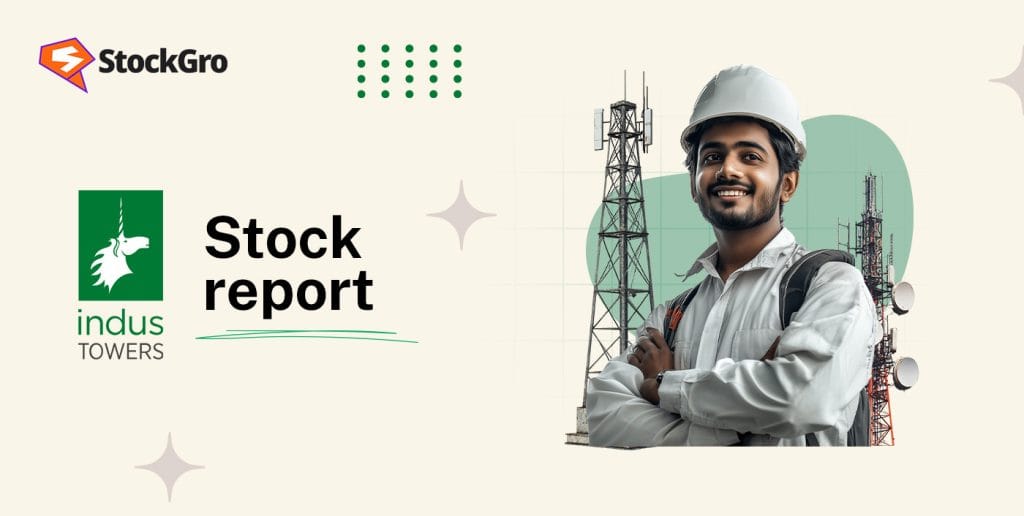
As India races towards a digitally connected future, the silent sentinels of this transformation are the telecom towers dotting its landscape. At the heart of this infrastructure revolution stands Indus Towers Limited, a company instrumental in enabling seamless communication across the nation.
But does Indus Towers offer a compelling case for long-term investors? Let’s delve deeper.
Stock overview
| Ticker | INDUSTOWER |
| Industry/Sector | Telecom (Service Provider) |
| Market Cap (₹ Cr.) | 1,05,883 |
| Free Float (% of Market Cap) | 49.96% |
| 52 W High/Low | 460.35 / 292.00 |
| P/E | 10.98 (Vs Industry P/E of 12.46) |
| EPS (TTM) | 37.13 |
About Indus Towers
Established in 2007 through a collaboration between Bharti Infratel, Vodafone Essar, and Idea Cellular, Indus Towers was envisioned to provide shared telecom infrastructure to operators on a non-discriminatory basis. The landmark merger with Bharti Infratel in November 2020 catapulted Indus Towers into becoming one of the largest telecom tower companies globally, boasting over 234,000 towers and 386,000 co-locations across all 22 telecom circles in India.
With Bharti Airtel now holding a majority stake of 50.00%, Indus Towers continues to play a pivotal role in India’s telecom sector, supporting major operators like Airtel, Reliance Jio, and Vodafone Idea.
Key business segments
Indus Towers operates primarily in the following key business segments:
- Tower infrastructure: The core business, providing shared telecom tower assets to multiple operators, helping them reduce capex and improve coverage.
- Power management: Managing and supplying uninterrupted power to telecom equipment through efficient energy management and battery backup solutions.
- Property and space leasing: Monetising unused spaces for hosting telecom infrastructure and future projects like IoT devices or small-cell networks.
Primary growth factors for Indus Towers
- 5G Expansion: India’s 5G rollout demands denser tower infrastructure. With its massive existing network, Indus is well-placed to support this surge.
- Rural Growth: As telecom services penetrate deeper into rural areas, Indus benefits from increased tower installations and higher tenancy.
- Green Energy Push: By adopting solar and lithium-ion solutions, Indus is cutting diesel use, improving margins, and aligning with sustainability goals.
- EV Charging Potential: Indus is piloting EV charging stations using its widespread tower sites—unlocking a future growth avenue.
Detailed competition analysis for Indus Towers
Key financial metrics – FY 24;
| Company | Revenue(₹ Cr.) | EBITDA (₹ Cr.) | EBITDA Margin (%) | PAT(₹ Cr.) | PAT Margin (%) | P/E (TTM) |
| Indus Towers | 28600.60 | 14556.60 | 50.90% | 6036.20 | 21.11% | 10.98 |
| Bharti Airtel | 149982.40 | 78291.80 | 52.20% | 5848.60 | 3.90% | 43.65 |
| Vodafone Idea | 42651.70 | 17126.00 | 40.15% | -31232.90 | -73.23% | -3.14 |
| Bharti Hexacom | 7088.80 | 3361.20 | 47.42% | 504.40 | 7.12% | 65.67 |
| TATA Communications | 20968.82 | 4230.10 | 20.17% | 949.59 | 4.53% | 40.17 |
Key insights on Indus Towers
- Achieved a robust revenue CAGR of 33% over the last 5 years, driven by strong tenancy growth and expanding digital infrastructure needs.
- Maintains industry-leading EBITDA margins consistently above 50%, reflecting high operating leverage and efficient cost management.
- Delivered a solid profit CAGR of 21% over the past 5 years, underpinned by steady top-line growth and margin resilience.
- Strong return metrics with an average ROE of 25.09% and ROCE of 34.93%, underscoring superior capital allocation and asset productivity.
- Demonstrated prudent financial management by reducing debt-to-equity from 0.51 in FY21 to 0.16 in FY24, significantly strengthening its balance sheet.
- Asset turnover ratio has improved from 0.37 in FY20 to 0.57 in FY24, indicating better utilisation of infrastructure assets and operational efficiency gains.
Recent financial performance of Indus Towers for Q3 FY25
| Metric | Q3 FY24 | Q2 FY25 | Q3 FY25 | QoQ Growth (%) | YoY Growth (%) |
| Revenue (₹ Cr.) | 7199.00 | 7465.30 | 7547.40 | 1.10% | 4.84% |
| EBITDA (₹ Cr.) | 3584.00 | 4863.80 | 6958.10 | 43.06% | 94.14% |
| EBITDA Margin (%) | 49.78% | 65.15% | 92.19% | 2704 bps | 42.41% |
| PAT (₹. Cr.) | 1540.50 | 2223.50 | 4003.20 | 80.04% | 159.86% |
| PAT Margin (%) | 21.40% | 29.78% | 53.04% | 2326 bps | 31.64% |
| Adjusted EPS (₹) | 5.72 | 8.43 | 15.17 | 79.95% | 165.21% |
Indus Towers financial update (Q3 FY25)
Financial performance
- EBITDA stood at ₹7,000 crore, marking a strong growth of 94% YoY and 43% QoQ, driven by operating leverage and improved collections.
- EBITDA margin expanded by 42.41% YoY and 27.04% QoQ, indicating enhanced efficiency.
- Adjusted net profit (excluding provision write-back) grew by 7.7% YoY and 9.6% QoQ, reflecting core profitability.
- The company realised ₹1,910 crore from the monetisation of Vodafone Plc’s secondary pledge shares. Along with significant dues clearance, this enabled a write-back of ₹3,020 crore from provisions for doubtful debt, bringing the total provision down to ₹500 crore.
- TTM Pre-tax ROCE and Post-tax ROE were healthy at 29.3% and 34.8%, respectively, showcasing strong return ratios.
Operational highlights
- In Q3 FY25, revenue mix was ~64% sharing revenue and ~36% energy reimbursements. For 9M FY25, the split stood at ~63% and ~37%, respectively.
- Core rental revenue rose by 7.5% YoY to ₹4,820 crore, supported by colocation growth and macro tower additions. Sequentially, rental revenue increased by 2.3%.
- The company added 4,985 macro towers during the quarter, taking the total to 2,34,643, along with 7,583 new co-locations, bringing the total to 3,86,819.
- Tenancy ratio improved to 1.65x, reversing the declining trend observed over the past few quarters.
Company valuation insights – Indus Towers
Indus Towers is trading at a TTM P/E of 10.98, below the industry average of 12.46, indicating attractive valuations. The stock has returned 11.06% over the past year, outperforming the Nifty 50’s 8.56% gain.
Growth is supported by strong tower additions, improved collections, and ongoing network expansion. While the 5G rollout has slowed, 5G loading continues to drive revenue and tenancy growth. Over 465,000 5G BTS have been deployed, and India’s 5G subscriber base is expected to reach 970 million by 2030.
In FY24, over 60% of new towers were installed in rural areas, enhancing digital reach. With rising data usage, regulatory tailwinds, and a projected tenancy ratio of 1.70x by FY27 (vs. 1.65x currently), Indus is well-positioned for long-term growth.
At 13x FY27E EPS of ₹34, the stock implies a target price of ₹440, offering a potential upside of 11%.
Major risk factors affecting Indus Towers
- Client concentration: Heavy reliance on Vodafone Idea, whose weak financials pose a revenue risk.
- Regulatory uncertainty: Policy changes in telecom norms or taxes could impact operations.
- Tech disruption: Shift toward small-cell or satellite tech may require significant reinvestment.
- Delayed receivables: Collection lags from telcos can strain working capital and liquidity.
Technical analysis of Indus Towers share

Indus Towers Ltd recently broke out of a rectangle pattern on the daily chart, signalling a potential bullish move after months of consolidation since October. This breakout, combined with broader market stability, presents a timely entry opportunity.
The stock is trading above all key moving averages, reinforcing the ongoing uptrend. The MACD is significantly positive at 15.82, with the line above the signal line, indicating strong bullish momentum. RSI stands at 71.87, reflecting overbought conditions and heightened buying interest, while Relative RSI remains positive over both 21-day (0.11) and 55-day (0.10) periods, showing consistent outperformance.
The ADX at 23.75 points to a developing trend that could strengthen with a sustained move above resistance. A breakout above ₹425 could unlock further upside toward the ₹440 target. On the downside, ₹375 acts as a crucial support level.
- RSI: 71.87 (Overbought)
- ADX: 23.75 (Developing Trend)
- MACD: 15.82 (Positive)
- Resistance: ₹425
- Support: ₹375
Indus Towers stock recommendation
Current Stance: Buy with a target price of ₹440 over a 12-month horizon. Indus Towers’ strong operating margins, 5G-linked growth potential, and improving fundamentals position it as a core infrastructure play in India’s digital transformation.
Why buy now?
Digital tailwinds: 5G rollouts, rising data usage, and rural connectivity are driving tower demand and tenancy growth.
Operational strength: EBITDA margins above 50%, improving asset turnover, and lower debt enhance financial resilience.
Improving fundamentals: Strong tower additions, better collections, and a target tenancy of 1.70x by FY27 support growth.
Attractive valuation: Trades at a P/E of 10.98 vs industry average of 12.46, with 11% upside based on FY27E earnings.
Portfolio fit
Indus Towers is a stable, cash-generating asset with strong earnings visibility—well-suited for portfolios seeking defensive exposure to digital infrastructure and secular growth from telecom capex. With robust financials, sectoral tailwinds, and an undervalued multiple, it fits portfolios focused on income stability, capital preservation, and exposure to India's digital growth.If you found this helpful and want regular stock trade calls, check out my community on StockGro here: https://app.stockgro.club/ui/social/tradeViews/groupFeed/07a7b961-b8ca-42ce-baf3-a9eec781b6ebIndus Towers: Budget 2025-26 opportunities
- Digital Infrastructure Push: Increased allocation for 5G rollout, BharatNet, and rural connectivity to boost tower demand.
- PLI for Telecom Equipment: Strengthens ecosystem, driving network expansion and co-location growth.
- Smart Cities & Urban Infra: Greater telecom density in urban projects to support higher tenancy.
- Green Energy Focus: Incentives for energy-efficient infra align with Indus’ sustainability goals.
- R&D and Skill Development: Support for telecom innovation and skilled manpower enhances long-term competitiveness.
Final thoughts
Indus Towers is the backbone of India’s digital connectivity. From every app you open to every payment you make, it’s towers that make it possible.
For investors, it offers stable cash flows, strong margins, and growth driven by 5G and digitisation, along with future opportunities in EV charging and green energy.
In a market full of flashy names, Indus stands out as a quiet performer with solid long-term potential.
